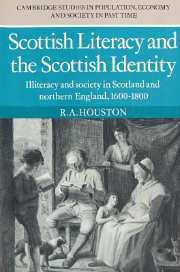 Scottish Literacy and the Scottish Identity
Scottish Literacy and the Scottish Identity Published online by Cambridge University Press: 11 November 2009
We have dealt in some detail with the period between the English Civil War and the onset of the Industrial Revolution in Britain. One aim of this book is to fill in gaps in our knowledge about this century. However, we cannot entirely ignore earlier times. As far as the decades between the accession of Elizabeth and the reign of Charles I are concerned the picture is relatively clear, at least for England. The important work of David Cressy has shown that the later sixteenth and early seventeenth centuries was an important period throughout England of substantially improving literacy for yeomen, and for craftsmen and tradesmen, but less so for women and the lower social ranks among men.
Of this earlier period there is unfortunately precious little we can say for Scotland. Sources are scanty and their reliability is open to question. Of 379 males who subscribed the 1581 Confession of Faith in the small town of Kinghorn in Fife, 84% were illiterate, as were all 414 women.2 Some patchy figures can be gleaned from the Justiciary Court 'Small Papers' – loose documents of the court – which suggest that levels of literacy among key groups were remarkably constant between the last quarter of the sixteenth century and the mid seventeenth century. Of twenty–nine craft and trade deponents at the Justiciary Court whose testimonies were subscribed between 1575 and 1660,48% were illiterate, and nine of eighteen for 1661-80. Many more depositions survive for this period, but most are innocent of any holograph subscription.
To save this book to your Kindle, first ensure [email protected] is added to your Approved Personal Document E-mail List under your Personal Document Settings on the Manage Your Content and Devices page of your Amazon account. Then enter the ‘name’ part of your Kindle email address below. Find out more about saving to your Kindle.
Note you can select to save to either the @free.kindle.com or @kindle.com variations. ‘@free.kindle.com’ emails are free but can only be saved to your device when it is connected to wi-fi. ‘@kindle.com’ emails can be delivered even when you are not connected to wi-fi, but note that service fees apply.
Find out more about the Kindle Personal Document Service.
To save content items to your account, please confirm that you agree to abide by our usage policies. If this is the first time you use this feature, you will be asked to authorise Cambridge Core to connect with your account. Find out more about saving content to Dropbox.
To save content items to your account, please confirm that you agree to abide by our usage policies. If this is the first time you use this feature, you will be asked to authorise Cambridge Core to connect with your account. Find out more about saving content to Google Drive.